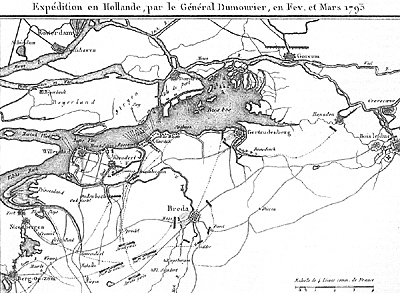Defense of the
Dutch Republic 1793
Dutch During the
Revolutionary Wars Part 11
Introduction
by Geert van Uythoven, Netherlands
| |
Illustration 11-1. French map of Dumouriez' advance and the Dutch defence in February and March 1793.
Jumbo Map (extremely slow: 372K)
The main defence would be behind the rivers Meuse and Waal where the French would have to use boats or bridges to cross. This would give the Dutch time to concentrate their troops on the threatened location, and a chance to inflict heavy casualties using artillery batteries and naval forces. Although some historians are of the opinion that the Stadtholder Willem V was much too reserved in his defence. And indeed both of his sons wanted to be much more active, and advocated a more active and offensive defence. However, time was not ripe for them to take the initiative. They were young and their qualities on the battlefield were still unknown, and their lack of experience did not help them in receiving the trust of their officers.
In addition, one has to keep in mind that the Dutch army was very weak, and that reports about the overwhelming French forces opposing it enforced a very careful strategy. Judging form our armchairs is easy, but, when reading the reports, ego-documents and other archival pieces of the period, there seems to be no other choice left then to use the strategy as it was executed.
Focusing on the defences of the riverfront, a number of measures were thought to be necessary, as listed in part 5 of the series. How these measures were put into effect is described in this part. As already described, the British were fully aware of the dangers that a French capture of the Netherlands would have for the safety of Britain. Therefore, there was no hesitation in sending troops. The British were also bound to do so by a defensive treaty. As the British troops would form an integral part of the Dutch defence, I will first treat their composition and arrival in the Dutch Republic.
Defense of the Dutch Republic 1793 Dutch in Revolutionary Wars Part 11
The Dutch During the Revolutionary Wars
|

 A
fter having described various sieges and the capture of a number of cities by the French in the southern part of the Dutch Republic, it is time to turn back to the overall defence of the Dutch Republic. As we saw in part 5 and 6 of the series, [1] it was assessed by the Dutch that the southern part of their territory was under the circumstances not defensible against a determined French attack. The decision was made to yield the terrain to them, except for some fortresses, which would be defended to hamper French movement and to force the enemy to use troops to blockade or besiege these.
A
fter having described various sieges and the capture of a number of cities by the French in the southern part of the Dutch Republic, it is time to turn back to the overall defence of the Dutch Republic. As we saw in part 5 and 6 of the series, [1] it was assessed by the Dutch that the southern part of their territory was under the circumstances not defensible against a determined French attack. The decision was made to yield the terrain to them, except for some fortresses, which would be defended to hamper French movement and to force the enemy to use troops to blockade or besiege these.